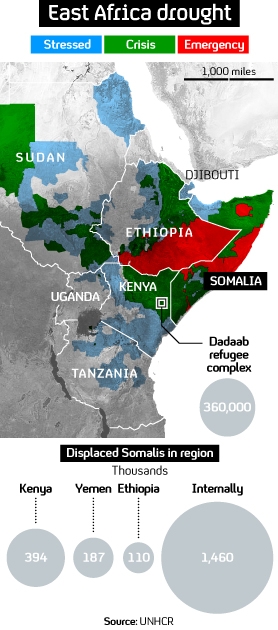East African drought ‘worst in 60 years’
A drought developing across the Horn of Africa is now the worst in 60 years – affecting 10 million people, according to the United Nations.

Djibouti, Ethiopia, Kenya, Somalia and Uganda are all affected, with the situation deteriorating to the point of famine in some areas, said Elisabeth Byrs, spokeswoman for the UN Office for the Coordination of Humanitarian Affairs.
“Over ten million people are affected by the drought in one way or other,” she said. “We believe that the drought situation in certain regions is the worst in 60 years. In several regions, we can speak of famine.”
The UN comments come on the heels of a warning by the charity Save the Children that Kenya’s biggest refugee camp, at Dadaab is becoming overwhelmed by refugees, some of whom have trekked for hundreds of miles to reach aid.
Around 20,000 have arrived at the Dadaab camp in the last two weeks, many having trekked for more than a month across parched areas of Somalia, Ethiopia and eastern and northern areas of Kenya itself.
“We are seeing around 1,300 people arriving in Dadaab every day, some in incredibly dire situations,” said the director of Save the Children’s Kenya programme, Catherine Fitzgibbon.
Interviewed on Channel 4 News, the International Director of Oxfam, Penny Lawrence, said that the failure of the last two expected periods of rain had left many people at breaking point.
“We are expecting the situation to worsen, because the next rains are due in October – so there is quite a period where people don’t have any access to food and what’s happened is the price of livestock has plummetted but the price of cereals has increased, so there is a huge hunger gap,” she explained.
“Children have made long journeys in terrifying conditions, often losing their families along the way and arriving at the camps in desperate need of security, health care and a normal life.” Catherine Fitzgibbon, Save the Children
Dadaab is the world’s largest refugee camp – built to house 90,000 people but already having to cope with four times that number. It has become the third largest settlement in the country and is beginning to struggle to cope.
Around two-thirds of the most recent arrivals are children, according to figures from UNHCR, the United Nations refugee agency.
- Chapters
- descriptions off, selected
- subtitles off, selected
- captions settings, opens captions settings dialog
- captions off, selected
This is a modal window.
This is a modal window. This modal can be closed by pressing the Escape key or activating the close button.
Melissa Fleming, a spokeswoman for the UNHCR, said growing numbers of refugees were settling outside the camp boundaries, with another 50,000 – mostly women and children – living in areas which were not structured and could be vulnerable to seasonal flooding.
“UNHCR is working with the Kenyan authorities and other aid agencies to respond to the latest crisis and to increased malnutrition among the new arrivals,” she said. “We and our partners are working around the clock to ensure that people are registered and quickly have access to assistance.”
Save the Children staff who work in the camp report that the children are arriving in an “exhausted, malnourished and severely dehydrated” condition.
“Children have made long journeys in terrifying conditions, often losing their families along the way and arriving at the camps in desperate need of security, health care and a normal life,” said Catherine Fitzgibbon.
“Nearly every child or parent we have spoken to says they are not just fleeing fighting in Somalia – the drought and food crisis are equally perilous to them now.”

Fatuma spent six weeks walking to Dadaab with her four children from their home in Somalia. By the time they reached Dadaab, the children’s feet were covered in blood, sand and blisters.
“The weather was very harsh. It was so hot and there was very little shelter,” she told the charity. “I left my husband in Somalia. I do not know if I will see him again.”
She said the well in her village and in the neighbouring village had both run dry. “We had animals – 15 goats,” she added. “But they died one by one because of the drought. There was nothing for them to eat.
“After all the goats had died I had to ask other people to give us food. It was hard because they also had no food to give.”